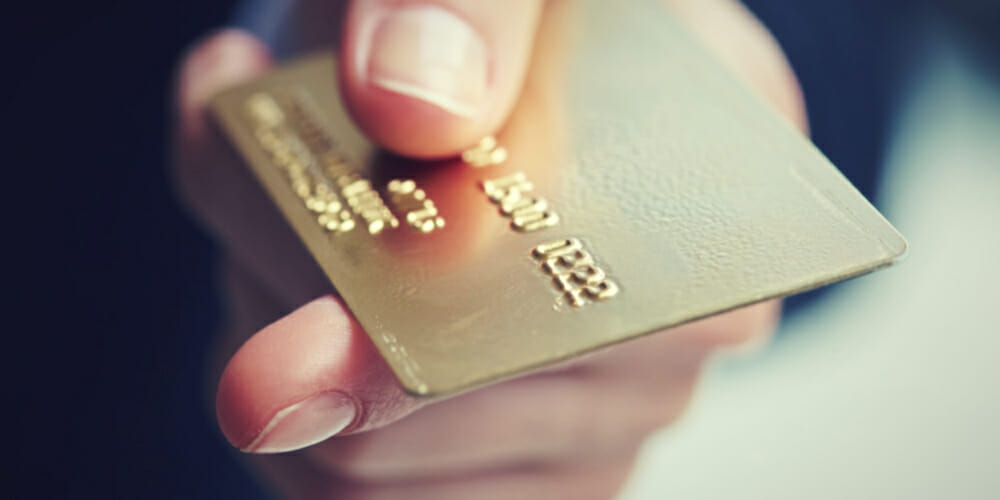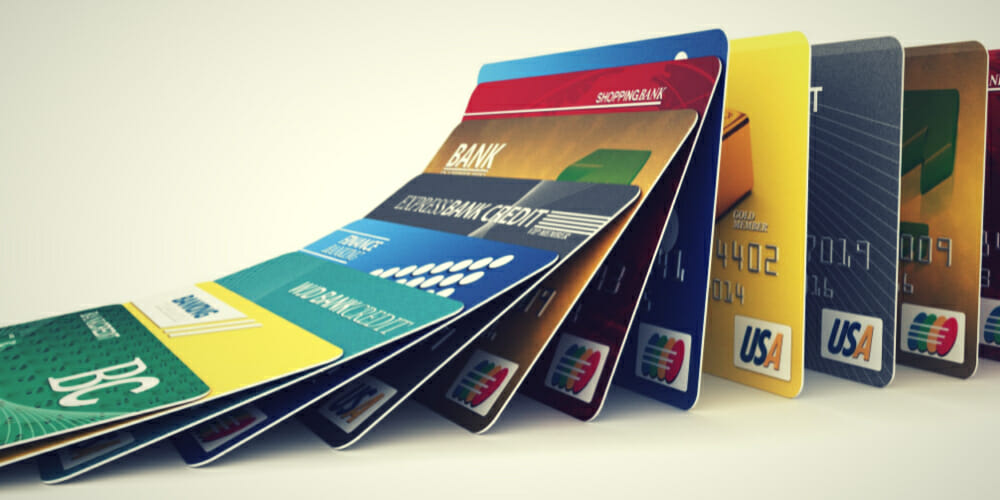You’re not alone if you’ve ever wondered how thick credit cards are. Many people are curious about the dimensions of these little plastic pieces that play a significant role in our financial lives. So, what is the thickness of a credit card?
The average credit card is only 0.03 inches, or 0.76 millimeters, thick, about the thickness of a few sheets of paper. This thickness can vary slightly depending on the card issuer and the type. For example, some premium credit cards may be slightly thicker than average due to additional features such as built-in RFID chips.
Additionally, some credit card issuers create thinner cards for use in mobile wallets such as Apple Pay or Google Pay. Despite these variations, the vast majority of credit cards are within a very similar range in thickness. This blog post will take a closer look at the anatomy of a credit card and explore how each layer contributes to its overall strength. So whether you’re new to credit cards or curious about their construction, read on for more!
What is a Credit Card?
Credit cards are plastic cards that allow consumers to borrow money to make purchases. They are issued by banks and other financial institutions and typically come with a credit limit and interest rate.
Consumers usually have to pay back the borrowed money plus interest and fees when purchasing a credit card. Most credit cards also come with rewards programs, which can give you points or cash back for making purchases on the card.
Credit cards can be beneficial in allowing people to make purchases that they may not be able to afford otherwise. However, they can also be very dangerous if misused. It is important to understand how credit cards work before using them. Otherwise, you may find yourself in a difficult financial situation.
Choosing the right credit card can be a difficult task. There are many factors to consider, such as credit limit, interest rate, rewards program, and annual fee. You need to compare different credit cards and choose the one that best suits your needs.
The following is a list of some of the most popular credit cards:
Visa
Visa is one of the largest credit card issuers in the world. Visa cards are accepted by millions of merchants worldwide. Visa offers a variety of credit cards, including cash back, travel, and business cards.
Visa credit cards offer a wide range of benefits and features that make them an excellent choice for many consumers. Here is a look at some of the key benefits of Visa credit cards:
- Wide Acceptance: Visa credit cards are accepted at millions of locations around the world. This makes them a great choice for those who travel frequently or purchase online.
- Rewards and Points: Many Visa credit cards offer rewards and points that you can redeem for cash back, merchandise, or travel. This is a great way to get something back while spending money on everyday purchases.
- Fraud Protection: Visa offers a high level of fraud protection for its cardholders. This can give peace of mind when making online and offline purchases.
- Flexible Payment Options: Visa credit cards offer flexible payment options that can be tailored to meet your individual needs. This can help you stay on top of your finances and make timely payments.
- Customer Service: Visa offers excellent customer service to its cardholders. This can be helpful if you have questions or need assistance with your account.
Mastercard
Mastercard credit cards are one of the most popular types available. Mastercard credit cards are versatile and can be used for various purposes. Whether you’re looking to finance a large purchase or simply want to earn rewards on your everyday spending, a Mastercard credit card can be a great option.
Mastercard offers a variety of credit cards, including cash back, travel, and business cards. They provide many benefits and features that make them a fantastic choice for many consumers. Here is a look at some of the key features and benefits that Mastercard credit cards offer:
- Mastercard credit cards offer a wide variety of rewards and perks.
- Mastercard gives you an o]ortunity to choose from various interest rates and terms.
- You can enjoy a wide range of credit limits using a Mastercard.
- Mastercard credit cards are accepted at millions of locations around the world.
Discover
Discover credit cards are one of the most popular types of credit cards available on the market today. Discover is a major issuer of both personal and business credit cards. The company offers various credit card products catering to spending needs and lifestyles. Whether you’re looking for a low-interest rate, cash-back rewards, or a no-annual-fee card, Discover has a credit card that’s right for you.
Some of the most popular Discover credit cards include the following:
- Discover it® Cash Back
- Discover it® Student Cash Back
- Discover it® Balance Transfer
These cards all offer great rewards programs and low-interest rates.
If you are looking for a Discover credit card, compare different cards and their offers before you decide which one is right for you. You can use our credit card comparison tool to help you find the best credit card for your needs.
American Express
American Express credit cards offer many features that make them an excellent choice for consumers. They offer a variety of perks, such as cashback and rewards points, that make them an attractive option for many people. Additionally, American Express credit cards come with several protections, such as fraud protection and extended warranties, that can give peace of mind to cardholders.
Some of the most famous American Express credit cards include the following:
-
- Platinum Card
- Gold Card
- Everyday Card
The Platinum Card offers many perks and rewards, while the Gold Card has a lower interest rate. The Everyday Card is a great option for those who want to earn points on everyday purchases.
No matter what type of credit card you are looking for, there is sure to be one that meets your needs. Be sure to compare different credit cards before choosing the right one.
How To Choose A Credit Card?
It is crucial to choose the right credit card for your needs. Here are some things to consider when choosing a credit card:
- Credit limit: This is the maximum amount of money you can spend on the card in a month. The cardholder can make purchases up to this limit and may be required to pay back the borrowed funds plus interest and other fees. You should choose a credit limit you can comfortably pay back each month.
- Interest rate: This is the amount of interest you will be charged on any outstanding balance on the card. It is essential to choose a credit card with a low-interest rate so that you can avoid paying excessive amounts of interest.
- Rewards program: Many credit cards come with rewards programs, which can give you points or cash back for making purchases on the card. Choosing a credit card with a rewards program that fits your spending habits is important.
- Annual fee: Some credit cards come with a yearly fee, which is typically a few hundred dollars. Before applying, it would be best to consider whether the card’s benefits are worth the annual fee.
Types of Credit Cards
There are many different types of credit cards available, each with its own set of features and benefits. Some credit cards offer rewards programs that allow cardholders to earn points or cash back on their purchases. Other credit cards may offer 0% APR promotions, saving cardholders a significant amount on interest charges.
Here is a rundown of some of the most popular types of credit cards:
Standard Credit Cards
There are many different types of credit cards on the market, but standard credit cards are the most common. A standard credit card allows the cardholder to borrow up to a specific limit to purchase items or withdraw cash. The cardholder is then responsible for repaying the borrowed funds plus any interest and fees that may be incurred. Standard Credit Cards are issued by banks, credit unions, and other financial institutions.
A Standard Credit Card is widely accepted by merchants and can be used to make purchases anywhere that accepts credit cards. Standard Credit Cards typically have a higher credit limit than other types of credit cards, making them a good choice for larger purchases. Many Standard Credit Cards also offer rewards programs, such as cashback or points for every purchase, which can be redeemed for merchandise or travel.
Secured Credit Cards
A secured credit card is a type of credit card backed by a security deposit. The size of the security deposit is typically equal to the credit limit on the card. This deposit serves as collateral in case the cardholder defaults on their payments.
Secured credit cards are often used by people with bad credit or no credit history, as they are seen as a way to rebuild one’s credit. Many secured credit cards have high-interest rates and fees, so shopping around and comparing offers is important before applying.
Payment card history is the most important factor in credit scores, so using a secured credit card can be an excellent way to improve your credit score over time. Making on-time payments and keeping your balance low relative to your credit limit will help you build a good credit history and improve your chances of getting approved for unsecured credit cards.
How To Apply?
Applying for a secured credit card is typically a relatively straightforward process. You will need to provide some personal information and likely need to put down a security deposit, which can be done with a credit or debit card, cash, or even a savings account. Once your application is approved, you will receive your credit card and can start using it.
Repay Debt On Time
When using a secured credit card, it is crucial to remember that you are responsible for repaying any credit card debt you incur. If you do not make your payments on time, you will be subject to late fees and interest charges, and your credit score will suffer. Additionally, if you default on your payments, the issuer may keep your security deposit and close your account.
If used responsibly, a secured credit card can be a helpful tool in rebuilding your credit. By making on-time payments and keeping your balance low, you can improve your credit score over time and eventually qualify for unsecured credit cards with better terms.
Banking Cards
Banking cards are one of the most convenient ways to bank. They can be used to withdraw cash, make deposits, and even transfer funds between accounts. There are many different types of banking cards, each with its own set of features and benefits.
Debit Cards
Debit cards are the most commonly used type of banking card. They allow you to access your bank account funds directly without first applying for a loan or opening a line of credit. Debit cards can be used for purchases anywhere credit cards are accepted and can also be used to withdraw cash from ATMs.
Credit Cards
Credit cards are another type of banking card that can be used for purchases, but they work differently than debit cards. With a credit card, you are borrowing money from the credit card issuer and will be required to repay that loan with interest. Credit cards can also be used to withdraw cash from ATMs, typically resulting in additional fees.
Atm Cards
ATM cards are a type of banking card that can only be used at ATMs. These cards allow you to withdraw cash from your bank account but cannot be used for purchases. ATM cards typically have a daily withdrawal limit, so checking with your bank is necessary.
Prepaid Cards
Prepaid credit cards are banking cards that can be used like a debit or credit card but are not linked to a bank account. Instead, they are loaded with a set amount of funds by the cardholder. Prepaid cards can be used for purchases anywhere credit cards are accepted and can also be used to withdraw cash from ATMs.
Cash-Back Credit Cards
Cash-back credit cards allow cardholders to earn rewards on their purchases. Typically, these rewards are in the form of cashback, which can be used to offset future purchases or withdrawn from the account as cash. Cash-back credit cards typically offer higher reward rates than other types of credit cards, making them an excellent option for those who want to maximize their rewards.
There are two types of cash-back cards, but the two most popular are flat-rate and tiered cards. Flat-rate cards earn a set percentage back on every purchase, while tiered cards offer different levels of cash back based on your spending category.
There are a few things to remember when choosing a cash-back credit card.
- First, it’s important to understand how the card’s rewards program works. Some cards offer tiered rewards, meaning you’ll earn more cash back on specific categories of purchases. Others offer a flat rate of cash back on all purchases.
- It’s also important to consider the card’s annual fee and compare it to the value of the rewards you’ll be earning.
- Finally, ensure you understand the card’s redemption process to maximize your rewards.
If you’re looking for a great cash-back card, compare offers and find one that best suits your needs. And remember, the more you use your card, the more cash back you’ll earn!
Credit Card Dimensions
When it comes to choosing a credit card, the size and credit card thickness of the card may not be the most important factor. However, it’s still important to keep these things in mind to ensure your card will fit in your wallet or purse. Additionally, if you’re planning on using your credit card for travel, it’s a good idea to check the dimensions of your card before you leave to be sure it will fit in your wallet or purse.
A typical credit card is 3.37 inches wide and 2.125 inches tall. However, the size of a credit card can vary slightly from issuer to issuer. Additionally, the thickness of a credit card can also vary. The average credit card is about 0.76 millimeters thick, but some cards may be thicker or thinner.
Credit card dimensions can also be helpful when shopping for cases or sleeves to protect your card. Knowing the size of your credit card can also help you determine which ATMs will accept your card.
Card Materials
Credit card materials are the physical components that make up a credit card. There are a few different materials that credit cards can be made out of. The most common material is plastic, which is used for most credit cards on the market. Metal and gold are also used for some high-end credit cards.
Plastic
Plastic is the most common type of credit card material. It is durable and inexpensive, making it a popular choice for many consumers. Credit cards made of plastic can be either rigid or flexible. Rigid plastic cards are more common, as they are less likely to break or bend. Flexible plastic cards are often used for “premium” credit cards, as they are more durable than rigid cards and have a more luxurious feel.
Credit card plastics are made from various materials, each with benefits and drawbacks. The most common credit card materials are PVC, PET, and ABS.
- PVC (Polyvinyl Chloride) is the most common material used for credit cards. It is durable and flexible, making it ideal for cards that will be used frequently. PVC is also easy to print on, often used for cards with complex designs or logos. However, PVC is not recyclable, so it is not the most environmentally friendly option.
- PET (Polyethylene terephthalate) is another common credit card material. It is more durable than PVC and is also recyclable. PET is not as easy to print on as PVC, so it is not often used for cards with complex designs.
- ABS (Acrylonitrile butadiene styrene) is the most durable of the three materials. It is also recyclable and easy to print on. However, ABS is more expensive than PVC and PET, so it is not as common.
Metal
Metal credit cards are less common than plastic cards, but they are gaining popularity. Metal cards are more expensive to produce than plastic cards, so they are often only available to consumers with excellent credit. Metal cards often have a higher credit limit than plastic cards. Metal cards are more durable than plastic cards so they can withstand more wear and tear.
Credit cards are commonly made from metals such as brass, copper, gold, titanium, palladium, and brushed stainless steel. Each of these metals has unique properties that make it well-suited for credit card manufacturing.
- Brass is an alloy of copper and zinc that is often used in credit card manufacturing due to its durability and resistance to wear and tear.
- Copper is a soft metal widely used to make credit cards due to its malleability and ability to be embossed with raised lettering or designs.
- Gold is a precious metal often used in credit card manufacturing due to its rarity and high value.
- Titanium is a strong metal that credit card manufacturers use to make credit cards due to its lightweight and resistance to corrosion.
- Palladium is a rare metal often used in credit card manufacturing due to its high melting point and ability to block electromagnetic fields.
- Brushed stainless steel is a type of steel often used in credit card manufacturing due to its resistance to scratches and fingerprints.
Gold
Gold credit cards are the most exclusive and expensive type of credit card. They are typically only available to consumers with excellent credit. Gold cards often have a higher credit limit than other types of cards, as well. Gold cards are also more durable than other cards so they can stand up to more wear and tear. Gold cards often have special features, such as gold-plated hardware or exclusive access to VIP customer service.
What Are Some Things To Keep In Mind When Choosing Credit Card Materials?
If you are looking for a new credit card, compare the materials they are made of. Plastic cards are the most common, but metal and gold cards may offer some advantages. When choosing credit card materials, there are a few things to remember.
- First, you must ensure that you have suitable materials for your card. If you have a chip card, you will need a chip-enabled terminal.
- Second, you must ensure that your materials are compatible with the type of credit card you have. For example, you must use a Visa-compatible terminal if you have a Visa card.
- Third, you must ensure that your materials are up to date. For example, if you have a chip card, you must ensure that your terminal is chip-enabled.
- Fourth, it would help if you ensured that your materials were safe. For example, you should never give your credit card number to someone you don’t know.
No matter which material you choose, select a reputable credit card manufacturer to ensure your card is of high quality.
How Can You Keep Your Credit Card Safe?
There are a few things that you can do to help keep your credit card safe.
- First, make sure that you keep it in a protective case or wallet. This will help cushion and protect it from scratches and other damage.
- Second, be careful when you use your credit card. Avoid using it in areas where it could be easily damaged, such as on rough surfaces or near sharp objects.
- Finally, check your credit card regularly for any signs of wear and tear. If you see any damage, contact your credit card issuer immediately to get a replacement card.
By following these simple tips, you can help keep your credit card in good condition and avoid replacing it due to damage.
Standard Size of Credit Cards
Since its introduction in the 1950s, credit cards have become essential to modern life. Credit cards offer a convenient way to make payments, whether for everyday purchases or big-ticket items. But with so many different types and sizes of credit cards on the market, it can be tricky to know which one to use for your needs.
When it comes to credit cards, size does matter. Credit cards come in a standard size known as ISO 7810, which the International Organization for Standardization specifies. Most major credit card issuers use this size, so you can be sure that your card will fit into any wallet or card reader.
ISO 7810 specifies that credit cards must be rectangular with rounded corners and have a minimum size of 85.60 by 53.98 millimeters (3.370 by 2.125 inches). While ISO 7810 is the standard credit card size, some issuers offer slightly smaller or larger cards. Some banks and credit unions provide mini credit cards, which are about the same size as a driver’s license and can be easily carried in a wallet or purse. These cards usually have the same features as a standard credit card but may have a higher interest rate.
Other issuers offer jumbo credit cards, which are about twice the size of a standard credit card. These cards usually come with higher credit limits and lower interest rates. They can be helpful for people who carry a balance from month to month or who make large purchases often.
Weight
Like size, credit cards also have a standard weight. This weight is usually around 5 grams, though it can vary slightly from card to card. This weight makes them easy to carry around and use but also makes them susceptible to damage if they are not adequately protected. However, the heaviest credit card is the Platinum Card issued by American Express. It weighs 18.6 grams and is one of the top-rated credit cards in the world that offers exclusive offers and benefits.
Thickness
The standard thickness of a credit card is 0.76 mm (30 mils). The average credit card comprises three layers: the base layer, the core layer, and the coating. The base layer is made up of PVC, polyester, or fiber. The core layer is usually made of paper or polyester. The coating is a transparent, protective layer applied to the card’s front and back.
Reasons Why Credit Cards have Standard Size
Credit cards come in all shapes and sizes, but most card issuers use one standard size. Here are the reasons why credit cards have a standard size:
To Fit in Wallets and Purses
One of the main reasons credit cards have a standard size is that they can easily fit into consumers’ wallets and purses. This makes it convenient for people to carry their cards wherever they go.
To Be Easily Processed by Merchants
Another reason credit cards have a standard size is that merchants can efficiently process them. When merchants swipe a card, they need to insert it into credit card machines that read the card’s information. If credit cards were of different sizes, it would be more difficult for merchants to process transactions.
To Prevent Fraud
Another reason credit cards have a standard size is to prevent fraud. If credit cards were of different sizes, it would be easier for criminals to create fake cards that would be difficult to detect. Having a standard size makes it more difficult for criminals to commit fraud.
To Make Them More Durable
Another reason credit cards have a standard size is to make them more durable. Credit cards would be more likely damaged or bent if they were of different sizes. Having a standard size makes them less likely to be damaged and more likely to last longer.
To Allow for Easy Storage
Another reason credit cards have a standard size is to allow for easy storage. If credit cards were of different sizes, it would be more challenging to store them in a wallet or purse. Having a standard size makes them easier to hold and keeps them from taking up too much space.
Common Features of Credit Cards
Most credit cards have several features designed to make them more convenient and valuable for consumers. A credit card typically has the following features:
Account Holder Name
The account holder’s name is the name of the person who owns the credit card. This information is typically printed on the front of the credit card, along with the cardholder’s signature. The account holder’s name is also required when making a purchase using a credit card and must be entered into the credit card terminal to process the transaction.
The account holder’s name is of significant importance because it is used to identify the cardholder and verify that the person making a purchase is authorized to use the card. The transaction may be declined if the account holder’s name is incorrectly entered. For this reason, it is crucial to ensure that the account holder’s name on your credit card is accurate and up-to-date. You can update your account holder’s name by contacting your credit card issuer and requesting a change.
Signature Line
The signature line on a credit card is the line at the bottom of the card where the cardholder is supposed to sign. This signature serves as a way to verify that the person using the card is authorized to do so. In most cases, the signature is simply a formality and does not serve any real security purpose. However, a signature may be required to complete a transaction.
Magnetic Stripe
The magnetic stripe on a credit card is a small, raised area that contains encoded information. This information is used to track the cardholder’s account and transactions. The stripe is typically located on the back of the credit card, near the signature panel.
The information on a magnetic stripe is encoded in three tracks. Track one is used for encoding account number data, track two is used for encoding expiration date and other data, and track three is used for encoding security code data.
When a credit card is swiped through a card reader, the magnetic stripe is read, and the information is used to verify the cardholder’s identity and account status. This information is also used to process the transaction.
Magnetic stripes can be damaged by heat, water, or friction exposure. When this happens, the stripe may become unreadable, and the credit card will be declined. If you want to prevent this from happening, it is important to store credit cards in a cool, dry place. It is also important to keep them away from items that can generate heat or friction, such as keys or coins.
If your credit card’s magnetic stripe is damaged, you can contact your card issuer to have it replaced.
Credit Card Network Logo
A credit card network logo is a special symbol on the front or back of a credit card. This logo indicates which network the card belongs to and allows customers to easily identify which cards can be used for their transactions. The most popular credit card networks in the United States are Visa, Mastercard, American Express, and Discover. Each network has its logo, which appears on the cards issued by banks and other financial institutions participating in that network.
The Visa logo is a blue and white V with a curved bottom, while the Mastercard logo is red and yellow intersecting circles. American Express uses a simple blue and white rectangle with the company’s name in the center, while Discover has a green and yellow shield with a D in the middle. These logos are all easily recognizable and allow customers to identify which card they should use for their purchase quickly. By understanding the different logos, customers can be sure they are using the right card for their purchase and avoid any inconvenience of declined transactions.
When making a purchase, customers will typically look for the logo of their preferred credit card network. This ensures that the merchant will accept their card. For example, if a customer has a Visa card and wants to purchase at a store that accepts it, they will look for the Visa logo on the store’s credit card reader. If the logo is not present, the customer may assume that their card will not be accepted and choose not to complete the purchase.
Name of Issuing Bank
The issuing bank’s name on a credit card is typically printed on the front of the card, along with the credit card number and expiration date. The issuing bank is the financial institution that issues the credit card to the customer.
In most cases, the issuing bank also provides the customer with a line of credit. When a customer uses their credit card to make a purchase, the issuing bank pays the merchant for the transaction amount and then bills the customer for that amount, plus any interest and fees that may be due.
The issuing bank’s name is important because it is how customers can identify which financial institution is responsible for their credit card account. The name also appears on the customer’s credit card statement. For these reasons, customers need to be able to easily find and identify the name of their credit card issuing bank.
Credit Card Numbers
When you use a credit card, the number that is printed on the card is your credit card number. This number is unique to your card and is used to identify you as the cardholder when you make purchases or transactions.
Your credit card number is made up of several different parts, and each part has a specific purpose. The first part of your credit card number is the issuer identification number (IIN), which is used to identify the company that issued your card. The next part is the account number, which is unique to you and used to identify your account. The last part of your credit card number is the checksum, which is used to verify the validity of your card number.
The IIN is the first six digits of your credit card number and is also known as the bank identification number (BIN). The IIN is used to identify the issuer of your card and is used in the process of approving transactions. The unique account number is the next nine digits of your credit card number and is used to identify your specific account. The checksum is the last digit of your credit card number and is used to verify the accuracy of your card number.
When you make a purchase or transaction, your credit card number is passed through a machine that reads the IIN and individual account number. The device then uses the checksum to verify the accuracy of your card number. If the checksum is correct, the transaction is approved, and the purchase is completed.
Security Code
The security code on your credit card is a three- or four-digit number that helps to verify that you are the rightful owner of the card. This code is also called a CVC, CVV, or CV2 code. You may be asked to provide this code as an extra security measure when making online or phone purchases.
The code is typically printed on the back of your credit card, next to your signature. American Express cards have a four-digit code on the front of the card. Mastercard and Visa cards have a three-digit code on the back. Discover cards have a three-digit code located on the front of the card.
If you are asked to provide your security code, you must do so. This helps to ensure that your credit card information is safe and secure. When entering your code, double-check that you are using the correct numbers. If you are unsure of your security code, you can always contact your credit card issuer for help.
EMV chip
EMV, or Europay-MasterCard-Visa, is a global standard for credit cards with embedded microprocessor chips. These chips store and process data differently than traditional magnetic stripe cards, making them more secure and less susceptible to fraud.
To use an EMV card, you must insert it into a compatible reader or terminal. The chip will then generate a one-time code to authenticate the transaction. This code is unique to each transaction and cannot be reused, making it much more difficult for criminals to clone cards or commit fraud.
EMV cards are slowly being phased in throughout the United States, and many retailers are already using EMV-compatible terminals. However, not all cards are EMV-enabled yet, so it’s important to check with your card issuer to see if your card has an EMV chip.
While EMV cards are more secure than traditional magnetic stripe cards, they are not foolproof. It’s still important to use caution when making credit card purchases and to watch for signs of fraud. If you suspect your card has been compromised, contact your card issuer immediately.
Issuance Date
The date that appears on your credit card is the date of issuance. This is the date that your credit card company issued you the card. The issuance date differs from the date of activation, which is when you first use your credit card. The issuance date may also vary from the date of expiration, which is when your credit card expires. You should also know the difference between the dates if you are trying to determine how long you have had your credit card.
Expiration Date
The expiration date on a credit card is the date after which the card can no longer be used. This date is typically printed on the front of the card, along with the cardholder’s name and the card’s issuing bank.
Most credit cards have an expiration date on the last day of the month. Usually, three or four years after the card is issued. For example, if a cardholder’s name is John Smith and the expiration date on his credit card is 12/24, the card can be used until December 31, 2024. After that date, the card will no longer be valid, and John will need to get a new one from his bank.
The expiration date is important because it’s one of the things that credit card companies use to prevent fraud. If someone were to steal John’s credit card information, they would only be able to use it until December 31, 2024. After that, the card would no longer work.
Difference Between Expiration Date And Billing Cycle
It’s important to note that a credit card’s expiration date differs from the card’s billing cycle. The billing cycle is when a credit card bill is issued and when it’s due. For example, John’s credit card company might issue his statement on the first of every month and give him a due date of the 25th. His billing cycle would be from the 1st to the 25th of every month. On the other hand, the expiration date is the date after which the card can no longer be used, regardless of when the bill is due.
If you have a credit card with an expiration date of 12/24, you’ll need to get a new card from your bank after that date. Keep track of your expiration date, so you don’t end up with a declined card when you try to use it.
Customer Service Number
A customer service number is an eleven-digit number usually printed on the back of your card. It is used to verify your identity along with the identification cards and to help customer service representatives resolve any issues you may have with your account. If you do not have your customer service number, you may still be able to speak to a representative, but they may not be able to help you as much.
FAQs
Do Credit Cards Decompose?
While most organic things will decompose over time, credit cards are made of plastic, a polymer. This means that it will not decompose in the traditional sense. However, some things can cause credit cards to degrade. Exposure to sunlight, heat, and water can all cause credit cards to become brittle and break down. The UV rays in sunlight can cause the plastic to degrade, while heat and moisture can cause the card to warp.
How Bad are Credit Cards for the Environment?
Credit cards are one of the most convenient ways to pay for purchases, but they can also harm the environment. Every time a credit card is used, the issuer produces a new plastic card. This creates unnecessary waste and contributes to pollution. In addition, credit card transactions require energy to process, which makes emissions that can damage the environment.
If you are concerned about the environment, there are a few things you can do to reduce the impact of your credit card use:
- Use recycled or eco-friendly materials for your credit card.
- Choose a credit card with low or no emissions.
- Pay off your balance in full each month to avoid interest charges.
- Use your credit card for purchases you usually would pay for in cash.
With a little effort, you can help reduce the environmental impact of your credit card use. Do your part to protect the planet!
Who Owns a Black Card?
A Black Card is a credit card that American Express offers its high-end customers. Those who spend upwards of six figures or more a year are eligible for this card. It is one of the most exclusive and prestigious credit cards available and is reserved for those with excellent credit scores and high incomes. The card has several perks and benefits, including exclusive events and VIP treatment at restaurants and hotels.
The benefits of having a Black Card also include access to exclusive events and experiences, concierge service, and rewards points that can be redeemed for various items. For some, the Black Card is a status symbol demonstrating their success and wealth. For others, it is simply a way to take advantage of the many benefits that American Express offers.
What Material is the Black Card Made of?
The Black Card is made of a material known as “carbon fiber.” This material is solid and lightweight, making it ideal for use in products that need to be durable and easy to carry. Carbon fiber is also used in aircraft and aerospace applications because of its high strength-to-weight ratio. The material combines carbon fibers with a resin, forming the desired shape. Black Cards are typically made with a black finish but can also be found in other colors, such as silver or red.
Conclusion
So there you have it, the answer to the question – how thick are credit cards? Credit cards may seem simple, but as we can see, there’s quite a bit of technology and design that goes into them. And now you know just how much they vary in thickness! So the next time you’re holding a credit card in your hand, take a moment to think about how thin it is – and how much it can hold!
Now that you know, maybe you feel more confident about applying for your first one. As with anything else, make sure to research and compare different offers before choosing a credit card (or any other financial product) that’s right for you.













